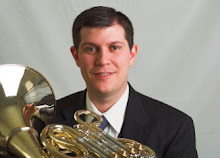Having studied with probably a good dozen professionals in the past few years, I've gotten quite a bit of information on "correct" embouchures. Largely, these professionals agree. However, what's startling and perhaps even disconcerting is how much they differ on some of the more valuable points.
Most every person that I have encountered encourages the "standard embouchure" that I describe above. However, that's about where it stops. Here are some categories where I found some of the biggest points of dissection.
Corners -
- Some tell you that your corners must always remain still regardless of the range of the instrument. Others tell you that there will be some movement. Still others make no comment and the amount of movement that they display ranges from very little to quite a bit.
- Some tell you that the corners should be pulled back and firm. Others tell you to bring them in towards the center. Some say to "relax" the corners as much as possible while playing; others tell you to always keep them firm.
- Some tell you to pull your corners back as you go higher (yikes...just seek out the "Expert Village" clip on YouTube) and others say to bring them inwards.
From my own experience and from what I've pieced together from my collective experience, the corners should:
- Remain mostly still but not be the focus of too much energy in keeping them still. They will move across different registers. As long as you can make these shifts without resetting the embouchure or you can easily change registers fluidly, a little movement isn't a big issue.
- Ideally be the source of power for the embouchure. However, this should always be controlled while relaxing as much as possible. If the corners are tight (pulled or pushed), it's energy spent in the wrong direction.
- Resemble the puckered smile that Phil Farkas refers to. They shouldn't be pulled or pushed hard in either direction. Essentially, the goal is to provide enough padding and vibrating surface inside the mouthpiece as possible. If the corners are pulled back too far, there's too little padding (pain) and a thin vibrating surface (ugly sound). If they are puckered in too much, you'll last all night, but you'll have little control or accuracy.
Obviously, everyone pretty much agrees that the 2/3 upper, 1/3 lower paradigm holds true. However, how to place the mouthpiece and the tiny, minute differences of a fraction of a millimeter that can make an embouchure work or not work aren't really addressed in this rule. Some will tell you to place the mouthpiece on the red of the bottom lip and to bring it as high on the upper lip as possible. Others will tell you to place the mouthpiece below the red on the bottom lip and then raise it. While I think this more of a matter of personal preference than other issues, it's still worth discussion.
From my observations, the lip needs to be below the red in the bottom lip. From there, the mouthpiece needs to be brought up to the top lip with a goal of getting as much top lip and bottom lip in the mouthpiece as possible. The ratio will work out to a nearly perfect 2/3-1/3 setup. This feels a little weird at first to those who have been setting into the red, but it affords a LOT more control from the powerful bottom lip that is so essential to flexibility.
Another way to determine the best placement (as well as mouth opening) is to place the mouthpiece directly on the teeth behind the lips. The outer edges of the mouthpiece should rest where the teeth and gums meet. What many will find is that this means their jaw is less open than they thought it needed to be.
Another consideration about the lips is the way in which each lip works. There is a great deal of difference in how people treat their top and bottom lips. Some will tell you that both lips vibrate equally, others will emphasize one over the other. Additionally, some will tell you that both lips equally control the opening/aperture while others will again emphasize one over the other.
Again, from many successful and unsuccessful trials, I have found the following to be inevitable truths about how each lip works.
The top lip:
- Is the vibrating lip. It accounts for the vast majority of the vibration. To prove this - do an open-air buzz. Place your finger firmly on your bottom lip. The pitch will change and the air may waiver a bit, but the buzz continues. Now, do the same buzz and place your finger firmly on your top lip. If the buzz doesn't promptly and entirely stop, then it is at least severely hindered.
- Is responsible for tone, timbre and power. If there is too little top lip, the sound will be brittle and edgy. If there is too much top lip, there won't be enough flexibility and the sound will be a bit like a pregnant euphonium. However, it is difficult to get too much top lip in. One other possible side effect of too much top lip is the dreaded double buzz. However, other conditions must be present for this to occur.
- Needs to be relaxed. If the top lip flexes or gets hard, the high range will disappear and the low range will not be flexible.
- Is the muscle lip. It allows you to control pitch by accurately altering the opening.
- Needs to be able to flex both up and down as well as in and out.
- Needs the whole lip muscle to be surrounded by the mouthpiece to operate correctly. This means, get the mouthpiece below the red if even just a little.

No comments:
Post a Comment